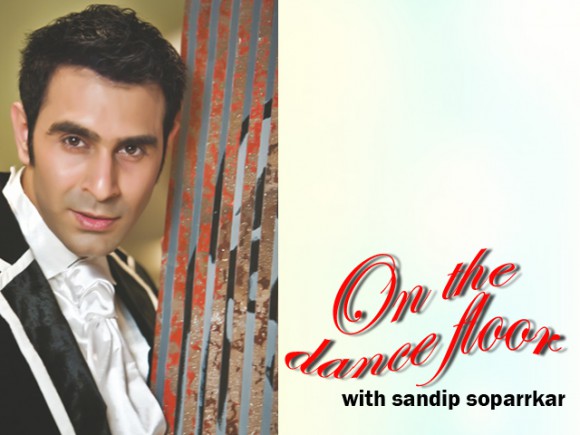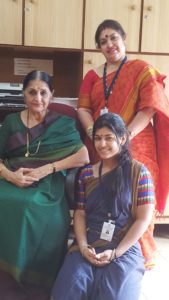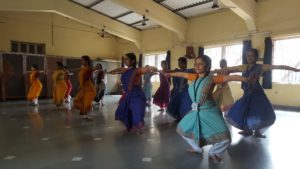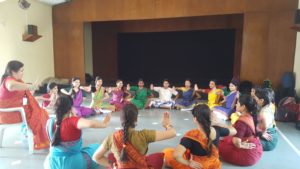Indian traditions with modern approach

In India, there are a number of privately run dance schools and institutions that teach various Indian classical dances. Some of these schools are run by renowned classical dancers but one institution that is class apart and has a made a name for itself all over the world is Nalanda Nritya Kala Mahavidyalaya with its headquarters in Mumbai.
As Nalanda celebrates 50 glorious years, I met and congratulated my friend Bharatanatyam exponent Uma Rele who is the principal of this institution that offers dance education to over a thousand dance lovers each year through full and part time courses in Bharatanatyam, Kathak, Mohiniattam, Kathakali and Odissi.
Nalanda Dance Research Centre, a non-profit public trust, is a premier institution that enjoys a unique position in the world of dance and education. Established in 1965 by renowned dance exponent and scholar Padma Bhushan and Padma Shri Dr Kanak Rele as an institution to impart traditional training in classical Indian dancing, Nalanda blossomed by 1973 into a unique three-tiered institution with foundation classes for pre-university children.
Nalanda Nritya Kala Mahavidyalaya, a college of classical dancing affiliated to the University of Mumbai, provides formal academic education and its different departments for post-doctoral and fundamental research. Nalanda Dance Research Centre is an officially recognised research institute by the Ministry of Science and Technology, Government of India and is the only dance institution to be so recognised. Acceptance of formal academics in dancing at the university level and recognition of dance as a full-fledged discipline for scientific research are the two pioneering achievements of Nalanda which have justifiably earned it the premier position.
Sitting in an office filled with books on dance, the gorgeous Uma Rele, drapped in a bright green and red Kanjivaram sari with a big red bindi on her forehead which made her glow with pride, shared a few insights about Nalanda. “There was a time when people felt our dance classes were a façade and that Nalanda was opened to supply girls to ministers and rich businessmen. But such allegation did not bother us and we kept doing our duties as an institution. Today, we are proud to have had students like renowned dancers like Deepak Majumdar, Vaibhav Rakri, Sharad Nair, Madhuri Deshpande.”
When you visit Nalanda, the sound of ghungroos along with tabla, mridangam and manjeeras catch your immediate attention. But when you walk into a classroom, it is not just Indian classical dance history one finds students learning. They are even taught the detailed evolution of western classical dance like ballet and shown videos to understand it better. At the institute, I met a few students who even learn classical western forms vike ballet and ballroom. It shows Nalanda as an institute completely believes that any classical dance is good to learn to build a good foundation for a dance lover.
Adding to our conversation, Uma Rele said, “At our institute, we follow the age-old guru-shishya tradition to impart dance knowledge. At the same time, we rejuvenate and adapt new training methods to meet scientific and technological demands of the fast changing contemporary society. We also conduct research projects that enhance the understanding, appreciation and knowledge about dance not only as a cultural phenomenon but also as an adjunct to human development.”
In 1972, on Nalanda’s proposal, the University of Mumbai introduced the Bachelor of Fine Arts (Dance), Master of Fine Arts (Dance) and PhD in dance degrees. A year later, Nalanda Nritya Kala Mahavidyalaya became the first exclusive college for dancing in the country affiliated to a premier university. This strong academic approach at Nalanda has created an ideal infrastructure with highly qualified personnel for conducting research in dance and allied arts. The research activities go beyond analysis and investigation of the technique and performance of dance; the selected projects are aimed at enriching dance for the future by further development and spelling out its intended impact on human life and also its usefulness to society.
While I was talking to Uma Rele, her dynamic dancer daughter Vaidehi walked into the office. A bundle of energy, Vaidehi was super-excitedly informed me that Nalanda had taken a new step ahead on its golden jubilee year. “This year, we have introduced a new course called Movement Science. A post-graduate degree, a Master of Fine Arts at the University of Mumbai, this course has everything in it from fitness programmes to exercise science to even yoga, kalaripayattu and other allied subjects.”
She added enthusiastically, “Dance is all about movements and there is a science involved in each movement, be it in classical Indian dance or any other dance forms. It is very important to study this science and through this course, we will be imparting complete knowledge of the science of movement.”
The new addition to the course celebrating five splendid decades just not ends here. I was informed by Uma Rele that apart from Movement Science course, Nalanda has introduced certificate course in folk dances of Maharashtra and Gujarat. So here a student will not just learn garbha, dandiya, lavni and all but will also get the theory and practical knowledge and training in rare dance forms like kupari, dandhi and more.
Years ago, eminent indologist, late Dr Moti Chandra had selected the motto and emblem for Nalanda — (विना तु नृत्यशास्त्रेण चित्रसुत्रम् सुदुर्विदम्) ‘Vina Tu Nritya Shathrain Chitrasootrum SuduVridum’ meaning without the knowledge of the science of dance, other plastic arts cannot be comprehended – Vishnudharmottara Purana.
Seeing a traditional institute take a modern approach is indeed a refreshing change for the dancers of today. This new addition to Nalanda and its teaching methods truly proves the vision of visionary Dr Kanak Rele who always believes in what the emblem of Nalanda showcases. It speaks of a dancer who stands on the foundation of Nalanda and is looking upward to the sky to soar on the wings of knowledge and success. Nalanda has more than justified his prophetic vision with this new addition. Today, with this article, I would like to wish Dr Rele and her entire dance family wonderful years filled with loads of knowledge of dance.




